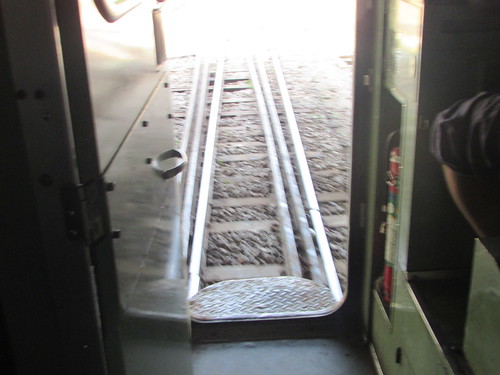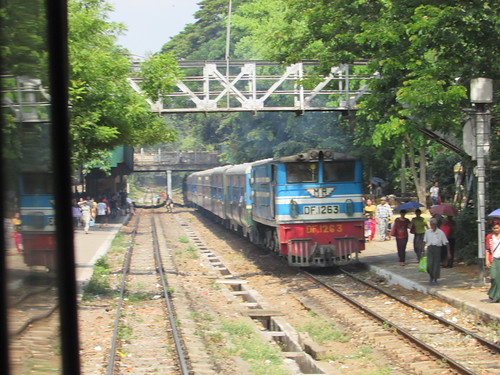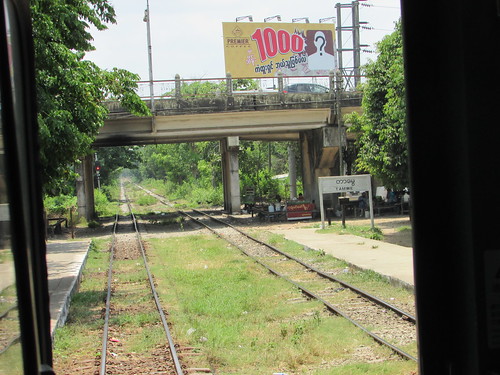We arrived at Yangon Central Station around 10.00 a.m. and found two DF.1200 class locomotives nicely posed side-by-side.
 DF.1213 on an arrival in platform 6 west next to DF.1220 in platform 5 light engine having brought a train into platform 6 east.
DF.1213 on an arrival in platform 6 west next to DF.1220 in platform 5 light engine having brought a train into platform 6 east.
I wondered if the train in platform 5 west would be the first departure but we were told platform 7 and presently one of the 'new' Japanese 5-car diesel multiple units, set RBE3045, arrived from the west and Aung and I boarded. I took up a position near the front, noting the open doors to the cab and at the front of the set which offered a reasonable view ahead. From time-to-time, I shared this view with other interested passengers.
We set off on a clockwise circuit of the 'Circular Railway', leaving on what is designated the 'Up' line. I noticed the fearsome-looking check-railed trap points on the way from platform 7 to the main line.
 Negotiating fearsome-looking check-railed trap points on the way from platform 7 to the Up Main (clockwise Circle Line).
Negotiating fearsome-looking check-railed trap points on the way from platform 7 to the Up Main (clockwise Circle Line).
We were soon stopping at Pha Yar Lan station, passing DF.1263 (rather fetching in pale blue and white livery) heading for Yangon Central Station with a Down passenger train.
 DF.1263 (in blue and white livery) at Pha Yar Lan, heading for Yangon Central Station.
DF.1263 (in blue and white livery) at Pha Yar Lan, heading for Yangon Central Station.
I wasn't expecting the bright yellow Railway Gang Car and trailer which was following a few yards behind the passenger train!
 Railway Gang Car and Trailer closely following a Down passenger train on the Automatic Block section at Pha Yar Lan Station.
Railway Gang Car and Trailer closely following a Down passenger train on the Automatic Block section at Pha Yar Lan Station.
Most of the double-track Circle Line operates under 'Automatic Block' regulations with colour-light signals, where the occupation of an electrical track circuit by a passing train replaces each signal to 'danger', reverting to 'proceed' for a following train when the first train has passed clear of the track circuit. Because there is no signalman, regulations for automatic block usually allow a train to pass a 'Red' signal. Typically, under 'Stop and Proceed Rules' the driver must wait a predetermined time before moving off. On Yangon's Circle Line, trains don't stop but continue under caution at a 'Red' signal, presumably because of the low line speeds.
Our train was also in the 'Automatic Block' area. We passed a number of colour light signals displaying 'Yellow' aspects, marked clearly 'A' to indicate that 'Automatic Block' regulations appied, odd-numbered progressively from Yangon (automatic signals on the Down line used even numbers). Signal 'K48' (a 3-aspect colour light) was a 'Controlled Signal' where 'Stop' means 'Stop' (what they call in some countries 'Stop and Stay' as opposed to 'Stop and proceed'). However, 'K48' (worked by Kyee Myin Daing South Signal Cabin) was displaying 'Yellow', beckoning us into the station. After pausing at the station and passing a 'Yellow' 3-aspect colour light 'S15' (worked by Kyee Myin Daing North Signal Cabin), we were back in an 'Automatic' area. We passed DF.1631 noisily making its way to Yangon with another passenger train.
Signal 'A23' was displaying 'Red' but we kept moving. There was a permanent way gang working in the vicinity, which I at first assumed was the reason for the 'Red' signal. In Myanmar in the past, I've only seen ballast tamping and packing carried out manually, but this track gang was using a small portable generator and power tools.
 Permanent Way Gang with not a High Visibility Jacket in sight (but one hard hat - the foreman)!
Permanent Way Gang with not a High Visibility Jacket in sight (but one hard hat - the foreman)!
The next signal, 'A27', was also 'Red'. Again, we kept moving, but the reason was not revealed until we'd passed both 'A29' and 'A31' at 'Red' and were approaching 'A33', also 'Red', when we could see a preceding Diesel Multiple Unit halted at the next station with passengers getting on and off. We continued our stop-start journey (we, too, were 'Stopping All Stations'). From time to time, we were within two train lengths of the preceding train. At Gyogone station and level crossing, we passed a 5-car diesel multiple unit (RBE25112) on the Down line, with a green lower body and grey upper body. Having attempted to close the road crossing, the Crossing Keeper stood in the wide space between the two lines so that his grubby green flag was visible to both approaching trains. Only half-barriers are used in Myanmar (manual gates or barriers on wheels, bamboo poles or nothing, depending upon the importance of the crossing) so, despite the efforts of the crossing keepers, it's common for impatient users to continue to cross as trains approach.
 Gyogone Station with RBE.25104 ahead of us on the Up and RBE.25112 on the Down.
Gyogone Station with RBE.25104 ahead of us on the Up and RBE.25112 on the Down.
We caught up with the preceding train again as it waited for signal '1R' to enter Insein station, giving us a good view of the livery (green upper body, white lower body with blue lining) and running number (RBE.25104). Once that train had moved on, our train was detained for two minutes before the signal turned 'Yellow' for us with '5' displayed in the theatre-type route indicator for platform 5.
 The Power Signal Box at Insein.
The Power Signal Box at Insein.
When we left Insein, instead of the expected main signal '15R', the subsidiary aspect '55R' (two white lights displayed diagonally) was cleared.

Leaving Insein, instead of the expected main signal '15R', the subsidiary aspect '55R' was cleared.
Insein's last controlled signal '17R' was also red, but, up ahead, we could see a track worker removing a large red banner from our track, as the gang had finished their task and were walking back towards Insein.
Signals 'A41', 'A43' and 'A45' were all passed at 'Red' and, as we approached Phawkan, we again had a good view of the train we were following.
 Phawkan Station, with RBE.25104 leaving as we approach.
Phawkan Station, with RBE.25104 leaving as we approach.
After passing signals 'A47' and 'A49' at red, we stopped at controlled signal '9L' for two minutes, waiting for the preceding train to enter the junction station at Da Nyi Gone on the Pyay line.

Da Nyi Gone signal '9L' displaying a yellow without the four inclined lights for our Circle Line train.
After our station stop at Da Nyi Gone and no longer closely following a train, the series of automatic signals showed us 'Yellow' aspects and we continued past signal 'A59', made brief stops at Kyaikkale and Mingalardon Market stations before continuing to Mingalardon. Here, controlled signals, electrically-worked crossovers and position-light ground signals were provided to allow a locomotive-hauled train to terminate, run-round and return in the same direction from which it arrived.
 Mingalardon looking south, showing main signal, lower position-light subsidiary signal, crossover and position light ground signal.
Mingalardon looking south, showing main signal, lower position-light subsidiary signal, crossover and position light ground signal.
Signal 'A67' was 'Red' but, under Automatic Block rules, we kept going to Pa Ywet Seit Gone where, like Mingalardon, there were controlled signals, electrically-worked crossovers and position-light ground signals to allow a locomotive to run-round its train. Signal '4L' before the platform was yellow as we passed an unidentified 5-car diesel multiple unit in cream livery travelling in an anti-clockwise direction. A 'Green' at signal '2LM' allowed us to depart (there's also a position light subsidiary aspect '32L' on the same post) and we were then back under Automatic Block again, passing multiple unit RBE.25110 (green lower body, grey upper body). We made stops at each of the closely-spaced stations and passed multiple unit RBE.25112 for the second time (earlier seen at Gyogone station).
After a succession of 'Yellow' signals, 'A89' leaving Tamwe remained 'Red', I assumed because of equipment failure. As far as possible, any failure in signalling systems, such as track circuit failure, is designed to give a more restrictive indication but Automatic Block regulations allow trains to continue under caution.
 Tamwe station with 'Red' signal 'A89' beyond the road bridge.
Tamwe station with 'Red' signal 'A89' beyond the road bridge.
We passed yet another of the 'new' diesel multiple units (RBE.3030 in cream livery with partial orange and green waistline). The introduction of more of these second-hand train has reduced the number of locomotive hauled trains operating in the Yangon area.
 Diesel Multiple Unit RBE.3030 in cream livery with (partial) orange and green waistline.
Diesel Multiple Unit RBE.3030 in cream livery with (partial) orange and green waistline.
Our route then converged and ran parallel with the double-track Mandalay-Yangon line just as another train headed for Yangon was passing. We pulled up side-by-side with this train (re-powered DF.1622 on a short passenger train) at the four-platform Mahlwagon station.
Leaving Mahlwagon, the sweeping curves of the four-track main line on to Pazundaung always makes me think of the Queensville Curve, Stafford in England.
 Four-track sweeping curves between Mahlwagon and Pazundaung.
Four-track sweeping curves between Mahlwagon and Pazundaung.
At Pazundaung, two goods lines from Mahlwagon Marshalling Yard converge and run parallel. To the west of Pazundaung, there are complex junctions with various conflicting routes so it was no surprise to wait for signal 'P4' until DF.1220, hauling an Up Circle Line train, had snaked across the pointwork in front of us.
 Pazundaung, looking towards Yangon Central Station, as our train waits for DF.1220 to cross to the Up Circle Line. On the left, DF.2081 heads for Yangon on the Down Goods.
Pazundaung, looking towards Yangon Central Station, as our train waits for DF.1220 to cross to the Up Circle Line. On the left, DF.2081 heads for Yangon on the Down Goods.
Once the signal cleared, we slowly completed our journey back to Yangon Central Station. The journey had taken just under two and three quarter hours and had given us a fascinating insight into the operation of this suburban railway and the lives of those who use it.
All the pictures in this article are in the album Around the Circle line in 2016.
Related posts in my blog
The Circle Line, Yangon (2008).
Exploring Yangon's railways (2012).
Yangon Area Railways (2013).
Railway Signalling in Burma - Part 2: Colour Light Signals & Motor Points.
All my Myanma Railways posts.
My Pictures
Around the Circle line in 2016.
Kyee Myin Daing.
The Circle Line, Yangon (2013).
Cab Ride on the Circle Line (2014).
Circle Line Revisited (2012).
The Circle Line by DMU (2015).
The Circle Line, Yangon, Myanmar (2009).
Burma: Colour Light Signals & Motor Points.
Yangon Central Station.
Railways in Myanmar (2008).
All my Myanma Railways Pictures.
